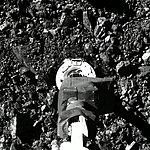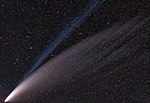SGR 1935+2154
SGR 1935+2154| 관측자료 에포크 J2000 이쿼녹스 J2000 | |
|---|---|
| 별자리 | 벌페큘라 |
| 적승 | 19시간 35m |
| 데클로네이션 | +21° 54' |
| 겉보기크기(V) | ? |
| 데이터베이스 참조 | |
| 심배드 | 데이터. |
| 기타지명 | |
SGR 1935+2154(또는 SGR J1935+2154)는 벌페큘라자리에 있는 고대의 항성 잔해로, 닐 게렐스 스위프트 천문대가 2014년에 처음 발견했습니다.[1] 현재 SGR-현상과 이와 관련된 비정상적인 X선 펄서(AXP)는 마그네타에서 발생하는 것으로 설명됩니다. 2020년 4월 28일, 우리 은하에서 약 30,000광년 떨어진 이 잔해는 빠른 전파 폭발 또는 FRB(FRB 200428로 지정됨)로 알려진 매우 강력한 전파 펄스 [2]및 이와 관련된 X선 플레어와 관련된 것으로 관찰되었습니다.[3][4][5] 이 탐지는 은하수 내부에서 발견된 최초의 FRB이자 알려진 근원과 연결된 최초의 FRB로서 주목할 만합니다.[6][7][8][9] 이후 2020년 SGR 1935+2154는 빠른 전파 버스트를 반복하는 것과 관련이 있는 것으로 밝혀졌습니다.[10]
역사
스위프트 버스트 경보 망원경(Swift Burst Alert Telescope)은 2020년 4월 27일 폭발이 감지되면서 잔해에서 활동이 증가했음을 천문학계에 처음으로 알렸습니다.[11] 다음 날 캐나다 수소 세기 매핑 실험(CHIME)[4][5]은 잔해 방향으로 400MHz에서 800MHz까지 두 개의 밝은 전파 폭발이 감지되어 전파 방출과 잔해 사이의 연관성이 확립되었음을 처음 보고했습니다. 그들은 그 폭발이 지금까지 자석에서 볼 수 없었던 [5][12]크랩 펄서의 가장 밝은 거대한 펄스와 비슷한 에너지를 가지고 있다고 추정했습니다. STAR2[13] 팀이 1.4GHz에서 버스트를 독립적으로 감지한 결과, 현재 FRB 200428로 명명된 버스트는 은하 외 거리에서 빠른 라디오 버스트(FRB)와 유사하며, 버스트의 영향력은 CHIME에서 보고한 1.5 MJyms [14]이상이어야 한다는 보고가 있었습니다. 가장 가까운 것으로 알려진 빠른 전파 폭발의 거리에서 FRB 200428은 >7 mJms의 영향력으로 감지되었을 것입니다.[14] 인테그럴, 코너스-윈드, 인사이트-HXMT, 아가일 망원경은 SGR 1935+2154에서 X선 폭발이 감지되었으며, 이는 CHIME과 STAR2 폭발과 동시에 발생했다고 보고했으며,[15][16][17][18] 이는 FRB가 X선 소스와 연관된 최초의 사례입니다. FAST(오백 미터 구경 구면 망원경)은 FRB 200428의 잔해와의 연관성을 더욱 확실하게 하기 위해 훨씬 더 약한 전파 폭발을 감지했다고 보고했습니다.[19] STAR2 및 CHIME에서 보고된 것과 일치하는 분산 측정을 통해 잔류물 위치의 최대 오차 범위 내에 국한되었습니다.
2020년 4월 29일과 4월 30일, NuSTAR, Swift, NIENER 위성은 잔해에서 짧은 X선 폭발을 여러 차례 관측하여 마그네트라가 여전히 활동 중임을 확인했습니다.[20] 초대형배열(VLA)은 FRB 200428 이후 1-2일 후에 나머지를 추적했지만 펄스 전파 방출이나 잔광을 발견하지 못했습니다.[21][22] 심층 우주 네트워크(DSN)는 FRB 이후 1.5일에서 3.5일 후에 잔여물을 관측했으며 주기적인 방출의 증거를 찾지 못했습니다.[23] LOFAR는 145 MHz에서 FRB 200428 이후 1.5일 후에 나머지 펄스에서 다른 펄스를 찾았지만 찾지 못했습니다.[24] 아레시보는 2019년 10월에 잔해의 활동 기간 동안 폭발을 감지하지 못했습니다.[25] Spektr-RG는 FRB 200428 4일 전에 잔해를 관찰했지만 불꽃 튀는 활동의 증거를 발견하지 못했습니다.[26] 후속 연구 및 관찰 결과가 보고되었습니다.[27][28][29][30][31][32][33] 2020년 6월 4일, 천문학자들은 2020년 5월 30일 메디치나 노던 크로스(MNC) 전파 관측소에서 "주기적인 전파 맥동"을 보고했습니다.[34] 또 다른 연구는 2020년 6월 6일 유럽 VLBI 네트워크와 함께 2020년 5월 13일에 관측한 것으로 보고되었습니다.[35] 다른 보고된 관찰 결과도 있었습니다.[36][37][38][39][40][41][42]
참고 항목
- SGR J1745-2900 – 은하수 중앙에 있는 궁수자리 A* 블랙홀 주위를 도는 최초의 발견된 마그네트라(magnetar)로
참고문헌
- ^ Cummings, J.R.; et al. (6 July 2014). "ATel #6294: Newly discovered SGR 1935+2154: Swift observations". The Astronomer's Telegram. Retrieved 27 February 2021.
- ^ Zhang, S.-N.; et al. (29 April 2020). "ATel #13687: Insight-HXMT detection of a bright short x-ray counterpart of the Fast Radio Burst from SGR 1935+2154". The Astronomer's Telegram. Retrieved 4 May 2020.
- ^ Drake, Nadia (5 May 2020). "'Magnetic Star' Radio Waves Could Solve the Mystery of Fast Radio Bursts - The surprise detection of a radio burst from a neutron star in our galaxy might reveal the origin of a bigger cosmological phenomenon". Scientific American. Retrieved 9 May 2020.
- ^ a b Starr, Michelle (1 May 2020). "Exclusive: We Might Have First-Ever Detection of a Fast Radio Burst in Our Own Galaxy". ScienceAlert.com. Retrieved 1 May 2020.
- ^ a b c Scholz, Paul; et al. (28 April 2020). "ATel #13681: A bright millisecond-timescale radio burst from the direction of the Galactic magnetar SGR 1935+2154". The Astronomer's Telegram. Retrieved 1 May 2020.
- ^ Hall, Shannon (11 June 2020). "A Surprise Discovery Points to the Source of Fast Radio Bursts - After a burst lit up their telescope "like a Christmas tree," astronomers were able to finally track down the source of these cosmic oddities". Quantum Magazine. Retrieved 11 June 2020.
- ^ Timmer, John (4 November 2020). "We finally know what has been making fast radio bursts - Magnetars, a type of neutron star, can produce the previously enigmatic bursts". Ars Technica. Retrieved 4 November 2020.
- ^ Cofield, Calla; Andreoli, Calire; Reddy, Francis (4 November 2020). "NASA Missions Help Pinpoint the Source of a Unique X-ray, Radio Burst". NASA. Retrieved 4 November 2020.
- ^ Andersen, B.; et al. (4 November 2020). "A bright millisecond-duration radio burst from a Galactic magnetar". Nature. 587 (7832): 54–58. arXiv:2005.10324. Bibcode:2020Natur.587...54C. doi:10.1038/s41586-020-2863-y. PMID 33149292. S2CID 218763435. Retrieved 5 November 2020.
- ^ Starr, Michelle (16 November 2020). "It's Official: The Fast Radio Burst Coming From Within Our Galaxy Is Repeating". ScienceAlert. Retrieved 17 November 2020.
- ^ Palmer, David (27 April 2020). "Swift detection of multiple bursts from SGR 1935+2154". GCN Circulars. 27657: 1. Bibcode:2020GCN.27657....1B.
- ^ Cordes, J. M.; Bhat, N. D. R.; Hankins, T. H.; McLaughlin, M. A.; Kern, J. (September 2004). "The Brightest Pulses in the Universe: Multifrequency Observations of the Crab Pulsar's Giant Pulses". The Astrophysical Journal. 612 (1): 375–388. arXiv:astro-ph/0304495. Bibcode:2004ApJ...612..375C. doi:10.1086/422495. ISSN 0004-637X. S2CID 252457.
- ^ Bochenek, Christopher D.; McKenna, Daniel L.; Belov, Konstantin V.; Kocz, Jonathon; Kulkarni, Shri R.; Lamb, James; Ravi, Vikram; Woody, David (1 March 2020). "STARE2: Detecting Fast Radio Bursts in the Milky Way". Publications of the Astronomical Society of the Pacific. 132 (1009): 034202. arXiv:2001.05077. Bibcode:2020PASP..132c4202B. doi:10.1088/1538-3873/ab63b3. ISSN 0004-6280. S2CID 210718502.
- ^ a b "ATel #13684: Independent detection of the radio burst reported in ATel #13681 with STARE2". ATel. Retrieved 15 May 2020.
- ^ "ATel #13685: INTEGRAL IBIS and SPI-ACS detection of a hard X-ray counterpart of the radio burst from SGR 1935+2154". ATel. Retrieved 15 May 2020.
- ^ "ATel #13686: AGILE detection of a hard X-ray burst in temporal coincidence with a radio burst from SGR 1935+2154". ATel. Retrieved 15 May 2020.
- ^ "ATel #13687: Insight-HXMT detection of a bright short x-ray counterpart of the Fast Radio Burst from SGR 1935+2154". ATel. Retrieved 15 May 2020.
- ^ "ATel #13688: Konus-Wind observation of hard X-ray counterpart of the radio burst from SGR 1935+2154". ATel. Retrieved 15 May 2020.
- ^ Zhang, C.F.; et al. (3 May 2020). "ATel #13699: A highly polarised radio burst detected from SGR 1935+2154 by FAST". The Astronomer's Telegram. Retrieved 3 May 2020.
- ^ "ATel #13720: Â X-ray monitoring of the active magnetar SGR 1935+2154". ATel. Retrieved 15 May 2020.
- ^ "ATel #13690: VLA search for persistent and bursting emission from SGR 1935+2154". ATel. Retrieved 15 May 2020.
- ^ "ATel #13693: VLA Monitoring of SGR 1935+2154 on 2020, April 30". ATel. Retrieved 15 May 2020.
- ^ "ATel #13713: A Search for Radio Bursts and Periodic Emission from SGR 1935+214 at High Radio Frequencies using the Deep Space Network". ATel. Retrieved 15 May 2020.
- ^ "ATel #13707: A LOFAR high time resolution search for radio bursts from SGR 1935+2154". ATel. Retrieved 15 May 2020.
- ^ "ATel #13726: Arecibo search for radio bursts following a previous SGR-like activity from SGR 1935+2154". ATel. Retrieved 15 May 2020.
- ^ "ATel #13723: SRG observations of SGR 1935+2154: four days prior to the FRB event". ATel. Retrieved 15 May 2020.
- ^ Naldi, Giovanni; et al. (17 May 2020). "ATel #13739: Search for radio bursts from SGR 1935+2154 at 408 MHz with the Northern Cross". The Astronomer's Telegram. Retrieved 17 May 2020.
- ^ Tohuvavohu, Aaron (21 May 2020). "ATel #13748: SGR 1935+2154: A catalog of X-ray burst times from Swift/BAT during the ongoing 2020 activity period". The Astronomer's Telegram. Retrieved 22 May 2020.
- ^ Tohuvavohu, Aaron (23 May 2020). "ATel #13758: SGR 1935+2154: A complete catalog of X-ray burst times from Swift/BAT imaging". The Astronomer's Telegram. Retrieved 24 May 2020.
- ^ Surnis, Mayuresh; et al. (30 May 2020). "ATel #13769: A search for radio pulsations from SGR J1935+2154". The Astronomer's Telegram. Retrieved 30 May 2020.
- ^ Bera, Apurba; et al. (1 June 2020). "ATel #13773: A uGMRT search for low-frequency persistent radio emission and afterglow from SGR 1935+2154". The Astronomer's Telegram. Retrieved 1 June 2020.
- ^ Surnis, Mayuresh; et al. (3 June 2020). "ATel #13777: Radio pulsation and imaging study of SGR J1935+2154 with the uGMRT". The Astronomer's Telegram. Retrieved 4 June 2020.
- ^ Roy, Jayanta; et al. (4 June 2020). "ATel #13778: Search for radio pulsations from SGR 1935+2154 with the uGMRT". The Astronomer's Telegram. Retrieved 4 June 2020.
- ^ Burgay, M.; et al. (4 June 2020). "ATel #13783: Marginal detection of radio pulsations from the magnetar SGR 1935+2154 with the Medicina Northern Cross". The Astronomer's Telegram. Retrieved 5 June 2020.
- ^ Nimmo, K.; et al. (6 June 2020). "ATel #13786: A search for persistent radio emission and millisecond-duration radio bursts from SGR 1935+2154 using the European VLBI Network". The Astronomer's Telegram. Retrieved 6 June 2020.
- ^ Surnis, Mayurexh; et al. (10 June 2020). "ATel #13799: Radio pulsation and imaging study of SGR J1935+2154 with the uGMRT". The Astronomer's Telegram. Retrieved 11 June 2020.
- ^ An, Tao; et al. (19 June 2020). "ATel #13816: MWA low-frequency radio imaging of SGR 1935+2154". The Astronomer's Telegram. Retrieved 19 June 2020.
- ^ Tan, Chia Min; et al. (29 June 2020). "ATel #13838 - Non-detection of radio pulsations from SGR1935+2154 by CHIME/Pulsar". The Astronomer's Telegram. Retrieved 29 June 2020.
- ^ Straal. Samayra; et al. (5 November 2020). "ATel #14151 - Search for burst and periodic radio emission from SGR1935+2154 using GBT observations at 800 MHz and S-band". The Astronomer's Telegram. Retrieved 6 November 2020.
- ^ Alexander, Rodin; Fedorova, Viktoriya (17 November 2020). "ATel #14186: Detection of radio emission from SGR 1935+2154 at the frequency 111 MHz". The Astronomer's Telegram. Retrieved 17 November 2020.
- ^ Kirsten, Franz; et al. (9 February 2021). "ATel #14382: Upper limits on the radio fluence of the most recent X-ray bursts from SGR1935+21". The Astronomer's Telegram. Retrieved 15 February 2021.
- ^ Borghese. A.; et al. (12 February 2021). "ATel#14388: Swift observation of the magnetar SGR 1935+2154 following the detection of several bursts". The Astronomer's Telegram. Retrieved 13 February 2021.
외부 링크






